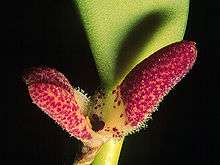Restrepiella ophiocephala
| Snake's head restrepiella | |
|---|---|
 | |
| Scientific classification | |
| Kingdom: | Plantae |
| (unranked): | Angiosperms |
| (unranked): | Monocots |
| Order: | Asparagales |
| Family: | Orchidaceae |
| Subfamily: | Epidendroideae |
| Tribe: | Epidendreae |
| Subtribe: | Pleurothallidinae |
| Genus: | Restrepiella |
| Species: | R. ophiocephala |
| Binomial name | |
| Restrepiella ophiocephala (Lindl.) Garay & Dunst. | |
| Synonyms[1] | |
| |
Restrepiella ophiocephala, commonly called the Snake's head restrepiella is an epiphytic orchid native to Mexico, Central America, Colombia, and Florida.[1][2][3][4][5] The epithet ophiocephala is derived from the Greek words ophis (snake) and cephalos (head).
Restrepiella ophiocephala grows from a short, creeping rhizome as a tufted, robust epiphyte to a length between 8 and 35 cm. The stout, cylindrical stem is erect and about 15 cm long and has a tubular bract. The fleshy, oblanceolate leaves are 8 to 18 cm long and have a short petiole. The tiny single flowers have a length of about 2 cm. They grow from the base of the leaves, one at a time, on up to four clustered inflorescences. They have a pale yellowish-brown color, dotted with dull purple spots. The outer surface is downy. The obovate, dorsal sepal is erect, while the lateral sepals are fused (synsepals) with a small split at their apex. The elliptic petals are much shorter and with ciliated margins. The fleshy lip is tongue-shaped. It occurs in damp forests alongside rivers at low altitude (40-1,600 m). The flowers are in bloom from winter to spring and are strongly scented.[6][7][8][9][10]
References
- 1 2 Kew World Checklist of Selected Plant Families
- ↑ Hammel, B.E. & al. (2003). Manual de Plantas de Costa Rica 3: 1-884. Missouri Botanical Garden Press, St. Louis.
- ↑ Pridgeon, A.M., Cribb, P.J., Chase, M.C. & Rasmussen, F.N. (2006). Epidendroideae (Part One). Genera Orchidacearum 4: 1-672. Oxford University Press, New York, Oxford.
- ↑ Nelson Sutherland, C.H. (2008). Catálogo de las plantes vasculares de Honduras. Espermatofitas: 1-1576. SERNA/Guaymuras, Tegucigalpa, Honduras.
- ↑ McLeish, I., N. R. Pearce & B. R. Adams. 1995. Native Orchids of Belize. 1–278.
- ↑ Garay, Leslie Andrew & Dunsterville, Galfried Clement Keyworth. 1966. Venezuelan Orchids Illustrated Volume 1 4: 266
- ↑ Balick, M. J., M. H. Nee & D.E. Atha. 2000. Checklist of the vascular plants of Belize. Memoirs of The New York Botanical Garden 85: i–ix, 1–246.
- ↑ CONABIO. 2009. Catálogo taxonómico de especies de México. 1. In Capital Nat. México. CONABIO, México D.F.
- ↑ Luer, C. A. 1991. Icones Pleurothallidinarum–VIII. Systematics of Lepanthopsis, Octomeria subgenus Pleurothallopsis, Restrepiella, Restrepiopsis, Salpistele, and Teagueia. Addenda to Platystele, Porroglossum, and Scaphosepalum. Monographs in systematic botany from the Missouri Botanical Garden 39: 1–161.
- ↑ Stevens, W. D., C. Ulloa Ulloa, A. Pool & O. M. Montiel. 2001. Flora de Nicaragua. Monographs in systematic botany from the Missouri Botanical Garden 85: i–xlii,.
External links
 Media related to Restrepiella ophiocephala at Wikimedia Commons
Media related to Restrepiella ophiocephala at Wikimedia Commons Data related to Restrepiella ophiocephala at Wikispecies
Data related to Restrepiella ophiocephala at Wikispecies- Photos from Belize Botanical Gardens
- IOSPE orchid photos, Restrepiella ophiocephala by J.Pfahl
- Orchid photographs by Gary Yong Gee, Restrepiella ophiocephala
- Lankaster Epidendra, Restrepiella ophiocephala
- Santa Barbara Orchid Estate, Orchid of the Day: June 5, 2014, Restrepiella ophiocephala
- Czech Botany, Restrepiella ophiocephala'